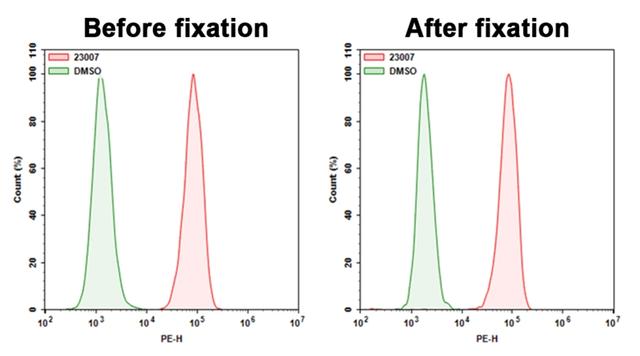Cell Meter™ Cellular Senescence Activity Assay Kit *Red Fluorescence*
Example protocol
AT A GLANCE
Treat samples as desired
Prepare and add Xite™ Red beta-D-galactopyranoside working solution to samples
Incubate samples at 37 °C for 15 to 45 minutes
Monitor the fluorescence intensity with fluorescence microscope using Cy3/TRITC filter set or flow cytometer using 575/26 nm filter (PE channel)
To ensure accurate results, allow all kit components to reach room temperature before beginning the experiment.
PREPARATION OF STOCK SOLUTIONS
Unless otherwise noted, all unused stock solutions should be divided into single-use aliquots and stored at -20 °C after preparation. Avoid repeated freeze-thaw cycles
Add 100 µL of DMSO (Component C) into Xite™ Red beta-D-galactopyranoside (Component A) and mix thoroughly.
Note: Divide any remaining Xite™ Red beta-D-galactopyranoside stock solution into individual single-use aliquots. Store these aliquots at -20°C, protected from light.
PREPARATION OF WORKING SOLUTION
To prepare the Xite™ Red beta-D-galactopyranoside working solution, mix 10 µL of the Xite™ Red beta-D-galactopyranoside stock solution with 1 mL of Assay Buffer.
Note: Xite™ Red beta-D-galactopyranoside working solution should be used promptly.
SAMPLE EXPERIMENTAL PROTOCOL
Treat your samples as desired.
Note: For 96 well plate format, grow cells in 100 µL of cell culture medium and treat as desired. Volumes can be adjusted based on the plate size.
Remove the cell culture medium and wash the cells with a buffer of your choice such as DPBS.
Note: For selectively tracking β-Gal in live cells, cells can be treated with Bafilomycin A1 for blocking endogenous β-Gal. The optimum concentration of Bafilomycin A1 may vary on the type of cells.
Add 100 µL of Xite™ Red beta-D-galactopyranoside working solution, and incubate the samples at 37 °C incubator for 15 to 45 minutes.
Note: The optimal time for incubation needs to be determined carefully.
Remove the working solution and wash cells with buffer of your choice.
Note: If performing flow cytometry for attached cells, cells can be trypsined at this step and collected in a tube.
Resuspend the cells in the Assay Buffer (Component B) and monitor the fluorescence intensity with a flow cytometer using a 575/26 nm filter (PE channel) or fluorescence microscope using a Cy3/TRITC filter set.
Spectrum
Product family
| Name | Excitation (nm) | Emission (nm) | Extinction coefficient (cm -1 M -1) | Quantum yield | Correction Factor (260 nm) | Correction Factor (280 nm) |
| Cell Meter™ Cellular Senescence Activity Assay Kit *Green Fluorescence* | 498 | 517 | 800001 | 0.79001, 0.952 | 0.32 | 0.35 |
Citations
Authors: Huang, Siping and Lau, Cia-Hin and Tin, Chung and Lam, Raymond HW
Journal: Cellular and Molecular Life Sciences (2024): 1--18
Authors: Scaramuzza, Shaun and Jones, Rebecca M and Sadurni, Martina Muste and Reynolds-Winczura, Alicja and Poovathumkadavil, Divyasree and Farrell, Abigail and Natsume, Toyoaki and Rojas, Patricia and Cuesta, Cyntia Fernandez and Kanemaki, Masato T and others,
Journal: Nature Communications (2023): 5071
Authors: Park, Chun Shik and Yoshihara, Hiroki and Gao, Qingsong and Qu, Chunxu and Iacobucci, Ilaria and Ghate, Pankaj S and Connelly, Jon P and Pruett-Miller, Shondra M and Wagner, Ben and Robinson, Camenzind G and others,
Journal: Cell Reports (2023): 112804
Authors: Pham, Alexander M and Ortiz, Luz E and Lukacher, Aron E and Kwun, Hyun Jin
Journal: Cells (2023): 380
References
Authors: Rani, Mohammad Hasanuzzaman and Liu, Qunen and Yu, Ning and Zhang, Yingxin and Wang, Beifang and Cao, Yongrun and Zhang, Yue and Islam, Md Anowerul and Zegeye, Workie Anley and Cao, Liyong and Cheng, Shihua
Journal: Plant molecular biology (2020): 501-515
Authors: Saito, Yuki and Chikenji, Takako S and Matsumura, Takashi and Nakano, Masako and Fujimiya, Mineko
Journal: Nature communications (2020): 889
Authors: Tang, Yan-Long and Zhang, Cheng-Gui and Liu, Heng and Zhou, Yue and Wang, Ya-Ping and Li, Yuan and Han, Yan-Jun and Wang, Cui-Li
Journal: Medical science monitor : international medical journal of experimental and clinical research (2020): e918207
Authors: Lü, Guohua and Li, Lei and Wang, Bing and Kuang, Lei
Journal: Aging (2020)
Authors: Han, Xiaojuan and Chen, Honghan and Gong, Hui and Tang, Xiaoqiang and Huang, Ning and Xu, Weitong and Tai, Haoran and Zhang, Gongchang and Zhao, Tingting and Gong, Chuhui and Wang, Shuang and Yang, Yu and Xiao, Hengyi
Journal: The Journal of biological chemistry (2020)




